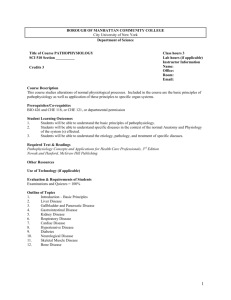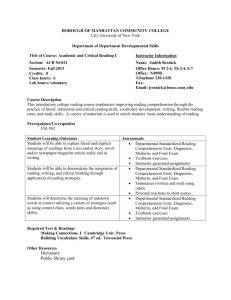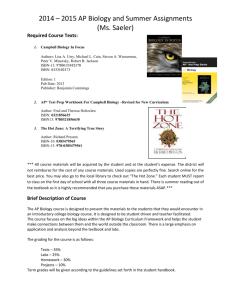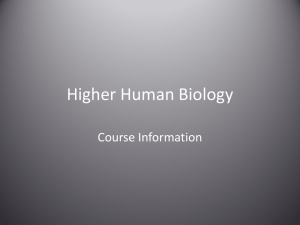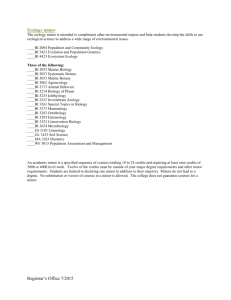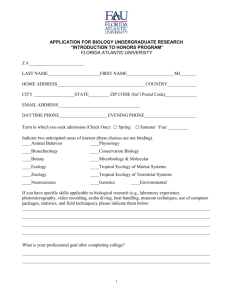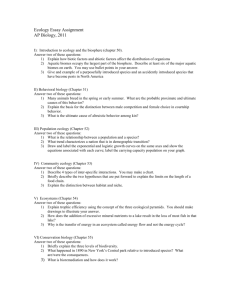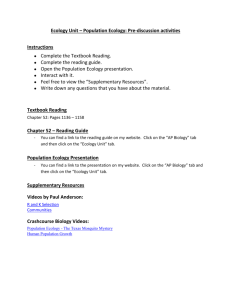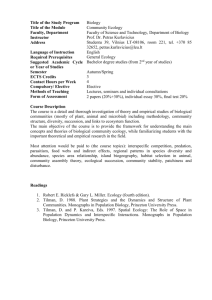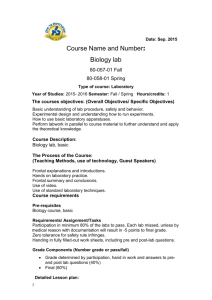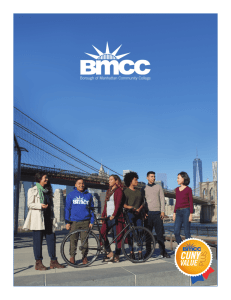Sample Syllabus - Borough of Manhattan Community College
advertisement
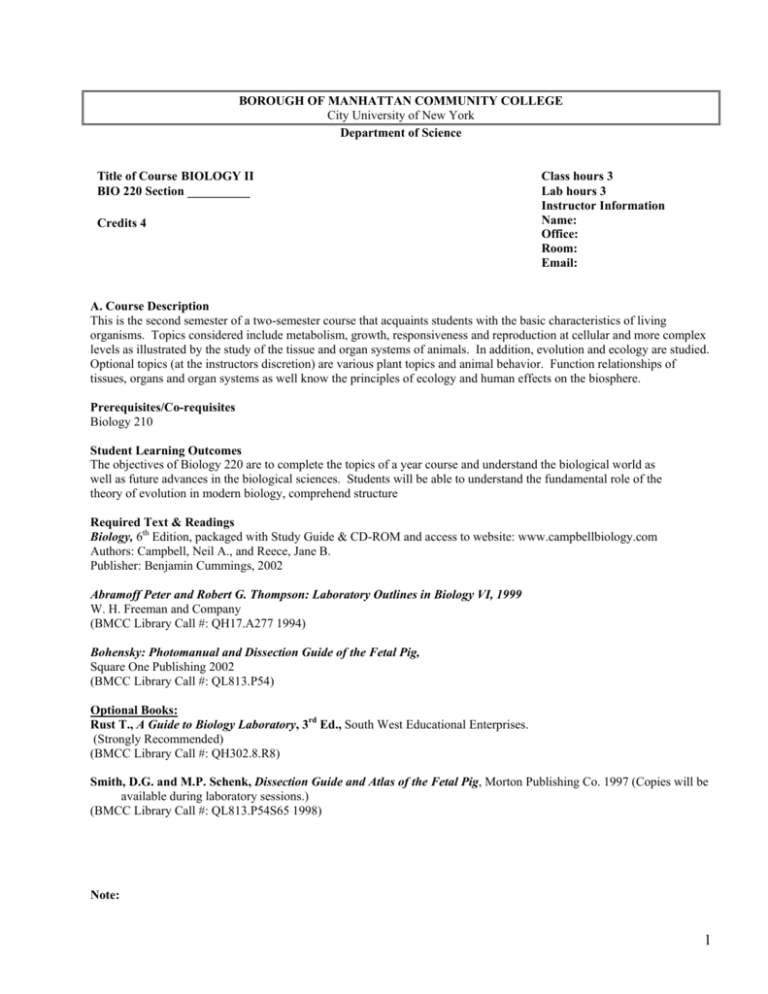
BOROUGH OF MANHATTAN COMMUNITY COLLEGE City University of New York Department of Science Title of Course BIOLOGY II BIO 220 Section __________ Credits 4 Class hours 3 Lab hours 3 Instructor Information Name: Office: Room: Email: A. Course Description This is the second semester of a two-semester course that acquaints students with the basic characteristics of living organisms. Topics considered include metabolism, growth, responsiveness and reproduction at cellular and more complex levels as illustrated by the study of the tissue and organ systems of animals. In addition, evolution and ecology are studied. Optional topics (at the instructors discretion) are various plant topics and animal behavior. Function relationships of tissues, organs and organ systems as well know the principles of ecology and human effects on the biosphere. Prerequisites/Co-requisites Biology 210 Student Learning Outcomes The objectives of Biology 220 are to complete the topics of a year course and understand the biological world as well as future advances in the biological sciences. Students will be able to understand the fundamental role of the theory of evolution in modern biology, comprehend structure Required Text & Readings Biology, 6th Edition, packaged with Study Guide & CD-ROM and access to website: www.campbellbiology.com Authors: Campbell, Neil A., and Reece, Jane B. Publisher: Benjamin Cummings, 2002 Abramoff Peter and Robert G. Thompson: Laboratory Outlines in Biology VI, 1999 W. H. Freeman and Company (BMCC Library Call #: QH17.A277 1994) Bohensky: Photomanual and Dissection Guide of the Fetal Pig, Square One Publishing 2002 (BMCC Library Call #: QL813.P54) Optional Books: Rust T., A Guide to Biology Laboratory, 3rd Ed., South West Educational Enterprises. (Strongly Recommended) (BMCC Library Call #: QH302.8.R8) Smith, D.G. and M.P. Schenk, Dissection Guide and Atlas of the Fetal Pig, Morton Publishing Co. 1997 (Copies will be available during laboratory sessions.) (BMCC Library Call #: QL813.P54S65 1998) Note: 1 1. There are textbook reading assignments for both lectures and laboratories. You will be tested on all textbook readings. For some laboratories there will be a write-up handed out. 2. Read the assigned pages in Abramoff and Thomson and/ or Bohensky each week before coming to the laboratory. At the Instructor’s discretion a quiz may be given in each or any laboratory. 3. A dissection kit containing a blunt (or mall) probe will be available for use during the laboratory sessions. The Bohensky manual and a dissection partner are required for laboratory beginning week (five). 4. Bring the laboratory manuals to laboratory every week. Use the CD that comes with the textbook; it is very helpful. My Biology 220 section is __________________________________________________________ It meets on ________________________ at _____________________ in room _________________ __________________________ at ____________________ in room _________________ Laboratory is on ____________________ from ___________________to_______________________ in room N-637 Other Resources Use of Technology (if applicable) Evaluation & Requirements of Students The instructor will administer 4 to 5 examinations. Most laboratories will begin with a pre-lab quiz. A final examination will cover both lecture and laboratory material. Students will be required to submit reports for some laboratory experiments. A term paper may be assigned at the instructor’s discretion. Outline of Topics Lecture A useful website for many topics covered in this course: http://users.rcn.com/jkimball.ma.ultranet/BiologyPages/ Week (s) Topics Textbook Reading Assignments 1-2 Evolution: Introduction, Definitions, History of Evolutionary Thinking, The Fact of Evolution. Evidence for Evolution, Darwin & Natural Selection, Population Genetics & Evolution, Speciation in Plants & Animals, Origin of Life, Age of the Earth Classification: Phylogeny & Systematics (Optional) Suggested web sites: pp. .9-12 Chapter 22 Chapter 23 Chapter 24 Chapter 26 Chapter 25 http://tolweb.org/tree/phylogeny.html http://www.talkorigins.org 2 3 Tissues, Organs, Organ Systems Histology, Intercellular Junctions, Homeostasis, Bioenergetics pp. 133-135 Chapter 40 4 Animal Nutrition: Nutritional Requirements and Nutrients, Intermediary metabolism Structure and Functions of the Digestive Tracts of Different Organisms Chapter 41 5-6 Internal Transport: Circulation in Animals Gastrovascular Cavities, Open and Closed Circulatory Systems, Structure and Functions of Vertebrate Circulatory Systems, Hearts, Blood Vessels, Lymphatic System, Blood and Lymph, Blood Cells, Gas Exchange in Aquatic and Terrestrial Animals, Avian and Mammalian Respiratory Systems, Transport of Gases Chapter 42 7 The Body’s Defenses: Immunology Non-Specific (Innate) and Specific (Adaptive) Immunity, Immunization, Autoimmune Diseases, Allergies, Immunodeficiency Diseases, AIDS Chapter 43 8 Homeostasis, Regulating the Internal Environment Thermoregulation, Osmoregulation and Waste Disposal, Excretory Systems of Different Animals, Kidney and Mammalian Blood Pressure Regulation Chapter 44 9 Chemical Signals in Animals: Endocrine Systems Signaling Modes, Invertebrates , Nervous and Endocrine Integration, Vertebrate Endocrine Organs and their Hormones, Hormone Actions and Controls Chapter 45 Plant Responses to Internal and External Signals (Optional)) 10 Animal Reproduction, Asexual, Mammalian Chapter 46 Structures, Functions, Gametogenesis, Hormonal Controls, Pregnancy, Birth Control Plant Reproduction (Optional) 11-12 Chapter 38 Neuromuscular Systems: Organization Chapter 48 Neurons, Potentials, Impulses, Synapses, Integration Vertebrate Nervous Systems, Brain Functions, Memory Sensory and Motor Mechanisms Sensory Transduction, Photoreception, Hearing and Equilibrium, Chemoreception, Movement and locomotion, Skeletons, Muscle contraction 13-14 Chapter 39 Chapter 49 Ecology Ecology and Environmentalism, Levels of Organization & Study, 3 The Abundance & Distribution of Organisms, Biomes Population Ecology; Predation, Demography How Populations Interact: Community Ecology, Human Impact on Populations Species Richness & Diversity , Productivity; Trophic Levels; Nutrient & Water Cycles Conservation, the Importance of Biodiversity, Habitat Destruction, Overpopulation, Introduced Species Suggested websites: Chapter 50 Chapter 52 Chapter 53 Chapter 54 Chapter 55 http://www.nrdc.org http://www.wcs.org http://nwf.org Behavioral Biology (Optional) Chapter 51 Laboratory Notes: A&T=Abramoff and Thompson; B=Bohensky; Write ups will be handed out the week before for some laboratory exercises. A Pre-lab quiz will be given at the beginning of most laboratory sessions Week (s) 1 Topics Evolution I. Taxonomy and Protista Lab Manual Pages A&T pp. 171-173; 185-193 2 Evolution II. A&T pp. 303-316, 325-333 Lower Animal Phyla Write-up pp. 1-6 A&T pp. 377-378-, 380-382 Textbook Pages/Other pp. 545-559 pp. 633-642; 652-654 659-662 3 Histology I: Introduction, Epithelia, Skin pp. 834-839 Microtome Demonstration 4 Histology II: Connective Write up p. 6 to end Tissues and Muscle Tissues Video: Muscle Contraction 5 Vertebrates: Skeletons; A&T pp. 375-387, External Anatomy of the 393-396 Pig and Frog and Dissection B pp. 1-10, 14, 18, of their Digestive Tracts 50-67 Video: Digestive System 6 Continue dissections 7 Circulatory System I: Sheep Heart and Frog Heart; Pig Thoracic Cavity 8 Circulatory System continued 9 Urogenital Systems of the Pig and Frog 10 Practical Examination on Material of Laboratories 5, 6, 7, 8, 9 A&T pp. 395-398, B pp. 68-73, 74-85, 86-102 Video: The Work of Heart A&T pp. 405-406 B pp. 105-112 Video: The Work of Kidney 4 11 1075 12 1075 13 Senses I: Eye, Write up pp. 3-4 Textbook: pp. 1057- Vision B. pp. 127-128 A&T pp. 422-425 Video Senses II: Taste Write-up pp. 1-3, 4-5 Olfaction, Touch, Hearing, Balance Video Nervous System, Spinal cord and Reflexes A&T pp. 414, 417-419 Textbook: Chapt. 48 Sheep Brain Dissection, B. pp. 120-126, A&T. pp. 409-414 Reflexes and A&T pp. 425-429 Cranial Nerve Functions 14 Textbook: pp. 1057- Ecology/Review/ Laboratory Final Examination (Instructor’s discretion) Video: Dissection & Anatomy of the Brain Video College Attendance Policy At BMCC, the maximum number of absences is limited to one more hour than the number of hours a class meets in one week. For example, you may be enrolled in a three-hour class. In that class, you would be allowed 4 hours of absence (not 4 days). In the case of excessive absences, the instructor has the option to lower the grade or assign an F or WU grade. Academic Adjustments for Students with Disabilities Students with disabilities who require reasonable accommodations or academic adjustments for this course must contact the Office of Services for Students with Disabilities. BMCC is committed to providing equal access to all programs and curricula to all students. BMCC Policy on Plagiarism and Academic Integrity Statement Plagiarism is the presentation of someone else’s ideas, words or artistic, scientific, or technical work as one’s own creation. Using the idea or work of another is permissible only when the original author is identified. Paraphrasing and summarizing, as well as direct quotations, require citations to the original source. Plagiarism may be intentional or unintentional. Lack of dishonest intent does not necessarily absolve a student of responsibility for plagiarism. Students who are unsure how and when to provide documentation are advised to consult with their instructors. The library has guides designed to help students to appropriately identify a cited work. The full policy can be found on BMCC’s web side, www.bmcc.cuny.edu. For further information on integrity and behavior, please consult the college bulletin (also available online). NAME, ADDRESS, AND TELEPHONE NUMBER OF CLASSMATES: __________________________________________________________________________________ __________________________________________________________________________________ __________________________________________________________________________________ __________________________________________________________________________________ __________________________________________________________________________________ __________________________________________________________________________________ __________________________________________________________________________________ __________________________________________________________________________________ 5
